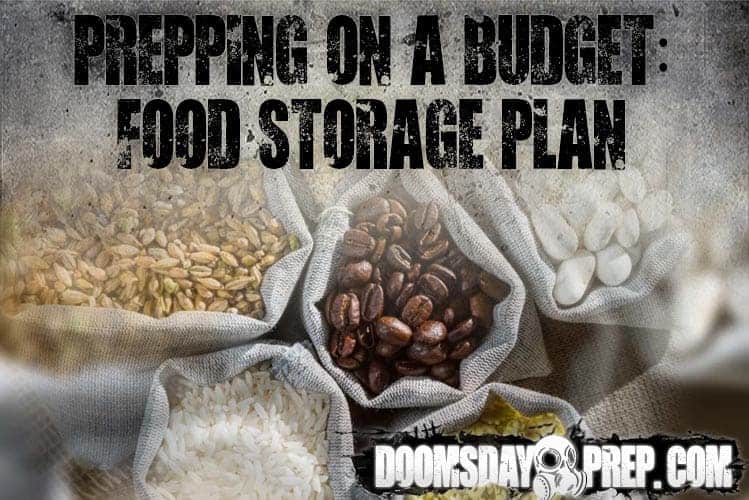No products in the cart.
How To
How to Prep on a Budget – Food Storage Plan
Starting a Food Storage Plan on a Budget
When you have to prep on a budget your food storage plan should be one of your first priorities. Always aim to have at least three days’ worth of food in your possession or in your storage area at all times. The more food you can keep the better. As well as having enough food supplies, you need to have the right ones. There is no point in having three days’ worth of canned fruit, as this alone will not sustain you during a survival situation when SHTF.
There are key foods that keep well that are also very budget-friendly. In addition to this, it is worth considering making and pickling your own food — this makes your food supplies last longer than simply purchasing cans and placing them on rotation. Remember, just as we wrote in the first article, prepping on a budget is a gradual process, so don’t worry if you feel as though you aren’t quite ready for an emergency situation yet! You will get there eventually, storing food $5-worth a week is still better than nothing at all.
Inexpensive Foods to Store
There are foods you can begin prepping with that are cheap and will provide most of the sustenance you need for a short period of time:
Rice: There are a number of benefits to rice. It is rich in carbs, it keeps for a very long time, is pretty filling, and is also farily inexpensive.
Beans or peas: Kidney beans, chick peas, and other beans are filling and contain plenty of protein,.
Peanut butter: High in protein, calories, and is very filling. Fun fact, peanut butter acts as a basis for a product called ‘plumpy nut’, which is given to children in the developing world suffering from malnutrition. This is because it is seriously rich in calories and contains the essential fats your body needs. Remember, in a survival situation, calories mean energy, and energy means survival.
Flour: This can be used as a basis for bread, or other cooking. It is cheap and great to keep on hand.
Pasta: We believe this is a food storage item that is commonly overlooked and unsung. Very inexpensive, it is also very easy to prepare, requiring only boiling water.
Out of all of these foods, kidney beans are certainly the cheapest. Rice is especially affordable when you buy it in bulk from wholesale stores. Peanut butter is fairly inexpensive, but the calorie per teaspoon value means it will last a long time, which means the upfront cost of a large jar soon balances out in a survival situation. Flour is great for experienced preppers as it has dozens of cooking uses.
Canned Goods
Canned goods are going to be your best friend when it comes to getting vitamins and minerals. Fruits and vegetables perish rapidly in a survival situation but can last for up to two years in cans. Buying store/generic brands products helps you save more money. When purchasing canned goods, you need to use them on rotation. This means you keep a log of the use-by date and use them before that point. When you use them, replace them with more supplies to keep your stocks replenished.
Starting a food storage plan with canned goods is a great way to bring non-preppers, family or friends, on board. This tactic allows for families that normally would not have extra food to easily add food to their pantry in a way that is very normal to them. Buying a few additional canned goods while you are at the grocery store is a simple first step, and one that could pay off big time. (Do you know how to open a can even if you don’t have a can opener?)
Self Sustained – Growing your own Food
Growing your own fruits and vegetables is a slow and gradual process, requiring at least one growing season and one harvesting season. Approach this in a smart way by purchasing a packet of seasonally relevant seeds when you first begin, which can be as little as $1. Alternatively, you could also buy one of our Heirloom survival seed vaults which contains hundreds of great seeds with 20+ vegetables. Grow them continuously and then jar or pickle them when the time comes to harvest. Pickled foods that are well-sealed and kept at temperatures below 75 degrees can last up to three years. In addition to this, grow herbs for medicinal and taste purposes. Once you invest a couple of dollars here and there to growing food—even small amounts in your kitchen—it is truly a great return on investment requiring only a few dollars and some sweat equity.
Finally, when prepping for food, meticulously keep an eye out for coupons. This may mean that you purchase dozens of beans one week and tons of rice the next. However, if you set yourself a budget of $10/mo and max this out as much as you can, you will soon see your food supplies growing. That would be $120 worth of seeds, food, and canned goods that you could have at the end of the year. We’ve said it a number of times already, but preparing even a little bit at a time is better than nothing at all.
What other ways do you know to save money while prepping? Please share with us in the comments below!

